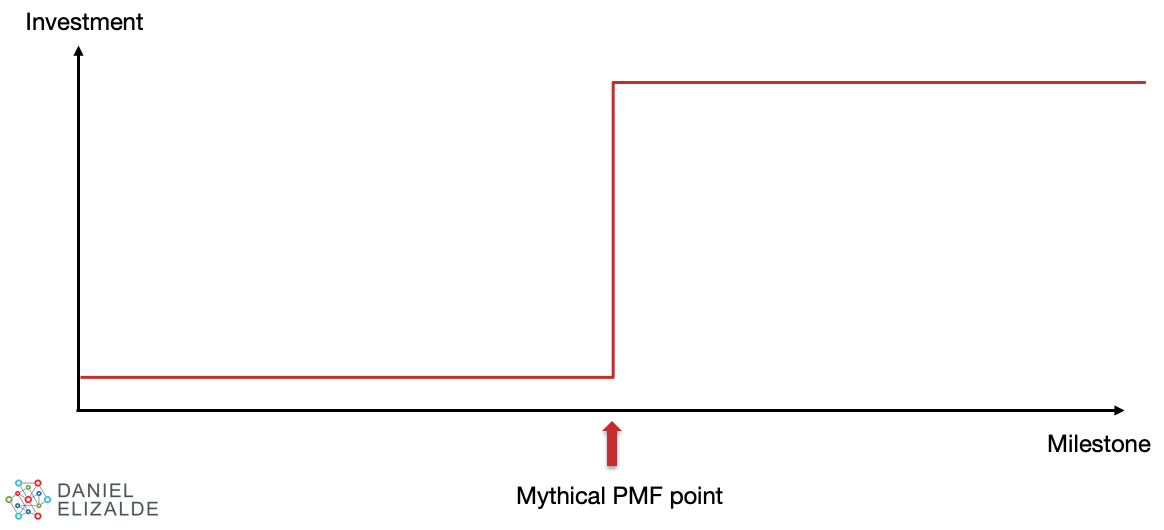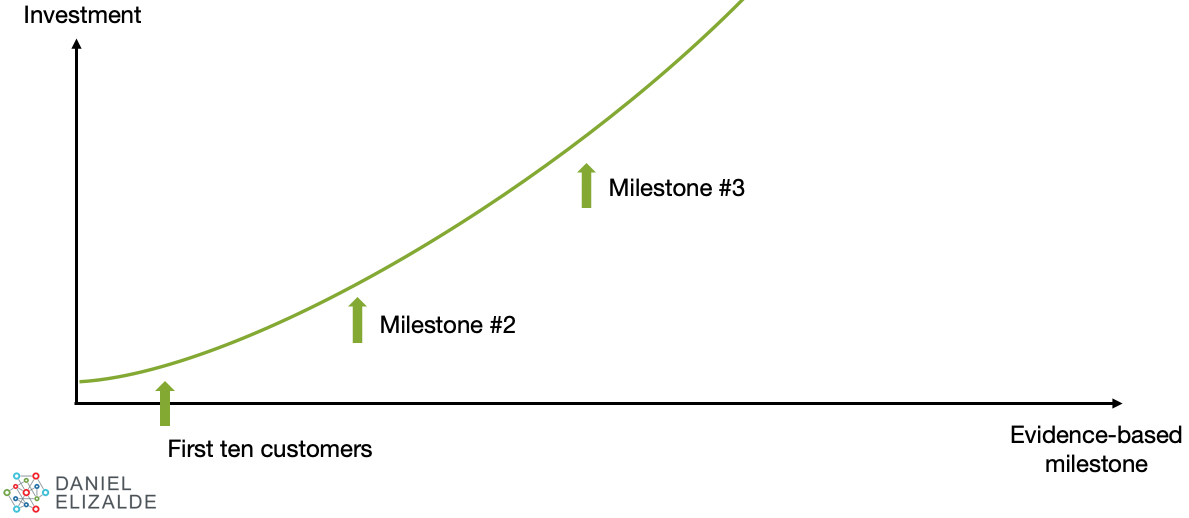
There is a big problem with the term product market fit. Launching successful products requires a rare combination of market understanding, iterative development, and a lot of luck. You also need clear milestones to align your company with your innovation efforts and retain the support of leadership.
Unfortunately, most companies operate with abstract terms and intangible metrics. Ask any Product Leader or Innovation team about the state of their product, and you’re likely to hear something about product market fit:
“We haven’t reached product market fit.”
“We need product-market fit to secure investment.”
“We will reach product-market fit this quarter.”
But what does product market fit actually mean? And how will you get there?
Our role as Product Leaders is to eliminate confusion, not add to it. That’s why, in my bestselling book, The B2B Innovator’s Map, I make a strong case to stop using “product-market fit” and instead focus on delivering value to your first ten customers.
The problem with product market fit
Product market fit has two primary shortcomings:
1) It means different things to different people.
2) You can’t measure it.
I’ve talked to hundreds of innovators and product professionals across multiple industries, and nearly everyone has a different understanding of product market fit. For some, it’s the magical place where your product meets market needs. Others define it as when your product starts flying off the shelf (without defining any meaningful metrics). And others have shared their complex set of OKRs per product, territory, and target market. Wow!
As I talked to more people, I was more and more convinced that something had gone wrong. I decided to go to the source and interview Steve Blank, the father of Lean Startup. When asked about product market fit, he jokingly said, “You know you’ve reached product-market fit when you don’t have to adjust your sales pitch in a month.” We had a good laugh, but that was as far as we got. You can listen to the full interview here.
Product market fit is a journey, not a destination
Product market fit was intended as a customer-validated justification for additional investment. If you reach product market fit, it means you have real-world evidence that your product has traction in the market. You’re at a stage where you can invest to start growing your product and driving toward scale.
If you are a startup, signaling product market fit might open the door for investors to consider you for a series A, B, or C round. It signals that your company is ready to grow the product team—maybe hire a sales team, look for partnerships, or expand to new markets. If you are part of a corporate innovation group, it might signal to the leadership team that your product is ready to transition out of incubation and into acceleration mode as part of a more established business unit.
Here’s the problem. If you can’t define product market fit, how can you use it as a gate for investment?
The reality is that investment for new products is not a binary proposition—meaning there is no magical threshold that signals you are ready to move from innovation to the growth stage. Here’s what most people think the mythical product market fit is. But, in the real world, product market fit is not the binary gate shown below.
Mythical Product Market Fit

This mythical product market fit point often results in failed products because it gives investors and company leaders the false impression that your product is ready to scale. It signals that there is a concrete point where you can transition from early product to scale in the blink of an eye. Unfortunately, this is not a reality and results in accelerated products that don’t meet customers’ needs (and waste a lot of time and money!).
Investment should be gradual and should match customer evidence. This means that in the early stages of your product, your investment should be very small. As you gain traction in the market by hitting clearly defined metrics, you can make the case for more investment. This approach makes product market fit a continuum instead of a specific point in time.
Investment milestones for each company will be different based on industry, type of product, maturity, etc. In general, I’ve found that a powerful first milestone is when you are able to deliver value to your first ten customers.
Real-world Innovation Journey

Why focus on your first ten customers?
Providing value to your first ten customers is a concrete milestone, removing the subjectivity of product market fit. With a concrete goal in mind, you have a greater understanding of your product’s direction and progress, leading to better alignment with your teams, clarity on your next steps, and the ability to learn faster.
If you focus your innovation strategy on your first ten customers, you can:
- Define a concrete milestone for making go/no-go decisions
- Understand what it takes to operate your product in the field
- Gain evidence on whether your solution is converging or diverging from the customer’s pain
- Set a clear target for your teams
- Track and communicate progress
Define a concrete milestone for making go/no-go decisions
Even if you have evidence that there is a market for your product, you won’t know if you can deliver on your value proposition until you test your product in the field.
After ten customers, you will have concrete evidence that your product has traction in the market AND that you can deliver the value you promised. At that point, you can confidently decide to continue investing in this product, change direction, or abandon the initiative altogether.
Understand what it takes to operate your product in the field
In Business to Consumer (B2C) markets, customers can start using the product right after they purchase it and immediately access the value promised by the vendor.
Business to Business (B2B) products, including Enterprise and IoT products, are different. To understand whether your product delivers value, you must traverse various stages of the enterprise customer lifecycle, including installation, deployment, onboarding, and operation. Getting to the operation stage takes significant effort.
Your first ten customers will serve as co-innovation partners willing to try your untested product. In exchange for solving their pain, you will get real-world insights into what it takes to operate your product in the field. That information is invaluable when creating an evidence-based roadmap for your next 100 customers.
Gain evidence on whether your solution is converging or diverging from the customer’s pain
A fact of enterprise products is that your customers are unique. As you work with more customers, you’ll find that each one has a slight (or sometimes considerable) variation of the pain you’ve discovered. You can’t assume that the learnings from one customer will scale to your overall target market.
By working with ten customers, you’ll start to see a convergence of customer pains and identify which pains repeat across your target audience. You’ll also gain a better understanding of which features should be part of your core solution, which should be add-ons, and which are opportunities for custom services.
Set a clear target for your teams
The milestone of 10 customers is a clear and concrete target for your teams to align and rally behind. There is no need to plan a long-term roadmap, ramp up an early sales team, or conduct other activities until you’re confident about market traction.
Having laser-focus on only your first ten customers helps your teams make decisions, move faster, and build just enough of your product to reach the next milestone.
Track and communicate progress
It’s your responsibility to keep the rest of the organization informed on the progress of your innovation efforts. But innovation milestones such as the number of discovery sessions or the number of experiments are usually not helpful for anyone outside of the Product team.
Instead, imagine how you could communicate with leadership and other groups if you had an agreement that your next significant milestone is reaching ten customers.
You can inform progress based on the number of prospects in the pipeline, the number of successful customers, and the number of remaining customers until the 10th customer milestone. These simple metrics empower you to show real progress on your initiative.
The Bottom Line
Driving innovation is a difficult and uncertain endeavor. But as a Product Leader, you can reduce confusion by avoiding abstract terms like product market fit.
Instead, focus on creating concrete and tangible milestones that the whole company can get behind. Your first milestone? Delivering value to your first ten customers. After all, if you can’t deliver value to your first ten customers, how do you expect to get your next 100 or 1,000 customers?
For a step-by-step blueprint on navigating the innovation journey and delivering value to your first ten customers, check out my book: The B2B Innovator’s Map: How to Get from Idea to Your First Ten Customers.
3 Comments
-
Couldn’t agree more – well said!
-
Amazing article, as always Daniel! Thanks for sharing
-
Author
Thank you so much Paulo!
-